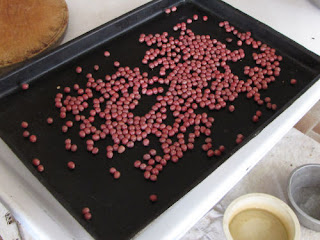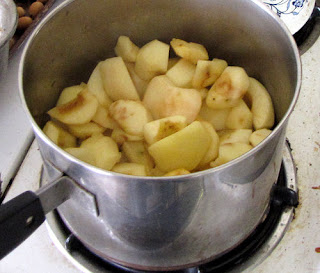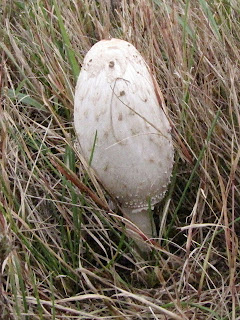 autumn olive juice right after processing (photo by jhy) autumn olive juice right after processing (photo by jhy) |
You will need: autumn olive berries- 1 c for each quart
3/8 c. sugar, or 1/8 c sugar and 1/4 c sugar substitute for each quart
quart canning jars
lids, rings
canner
jar lifter, potholders, etc
This method of making juice does not result in a beverage you can drink immediately, but it's incredibly easy. You have to wait a few months to drink the juice. When I discovered that autumn olive berries were edible, I had to try this, and the results are very much like a fruit punch.
I've used this method of making juice with several different kinds of fruit, but this post will focus on autumn olive. It is very easy, and doesn't require much work.
Wash and sterilize as many quart jars as you think you will need. You can cover with a clean towel and let them rest until you have the fruit ready.
You'll need one cup of clean autumn olive berries for each quart. Try to remove the small gray stems, but it won't matter if you miss a few. Most of them probably came off when you stripped the berries from the trees. See
Harvesting Autumn Olive
 autumn olive berries and sweetener, before adding boiling water (photo by jhy) autumn olive berries and sweetener, before adding boiling water (photo by jhy) |
Set water to boil- enough to fill all the jars you plan to use. Then, in each quart jar put 1 c of berries and 3/8 c of sweetener. This can be all sugar, or part sugar and part substitute. I have not tried it with all sugar substitute, but it would probably work since there is no texture issue in this recipe as there is with baking.
Fill jars with boiling water, leaving 1/2 inch headspace. Clean rim, put on lids and rings. Process 10 minutes in boiling water bath. See
basic instructions for hot water bath canning. canning.
 a glass of autumn olive juice with the berries crushed slightly to release some color (photo by jhy) a glass of autumn olive juice with the berries crushed slightly to release some color (photo by jhy) |
The just-processed juice will be clear to translucent. When the jars have cooled, remove rings and place the juice in a pantry or somewhere to store for at least three months before opening. Over this time, the juice will develop.
When you are ready to open the jars, the juice will still be almost clear. I found that crushing the fruit just a bit, to release some of the red coloring, makes a more attractive juice, although the taste is the same.
Strain and remove the remaining fruit. The juice is then ready to drink.

 watercress growing in a stream (photo by jhy)
watercress growing in a stream (photo by jhy) 


































